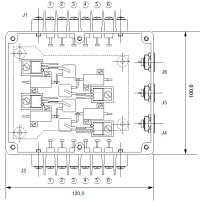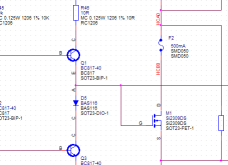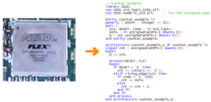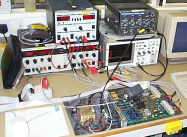 |
 |
 |
 |
 |
 |
 |
|
Firmware Root Page
Here you will find anything to do with electrical, electronic and embedded firmware systems. For the time being the scope of this page is somewhat constrained, despite it being my core formal competence. The main reason for this is that it's not something I have any practical scope to make use of. For me, both electronics and software are things I have formal knowldege of, and do to try and be useful in a general sense. My passion is for things mechanical. Like mechanical engineering, and unlike software, electronic engineering has a high degree of associated equipment cost. Certainly, as one approaches the edge of technology, test equipment and materials or components become prohibitively expensive. Much of the most innovative development occurs in this environment, and because of the expense, it is not an arena in which I can hope to compete alone. 
The time where simple electronic devices can be seen as innovative has long gone, unfortunately. Nevertheless, I am sure there are still inventions to be made in this arena, and I can assure you if I realise one of them, I'll be quick to try and capitalise, along with many, many, others! Key scientific developments in the arena of materials science are the primary drivers for such simple and innovative electronic devices. Typically these developments yield improvements in sensor, transducer and component techniques. The "miracle" is the core physics or chemistry that made the innovation possible, rather than the electronics per-sé. 
Secondary developments now, perhaps, seem to be the the main drivers for technological progress. Such developments make use of software, and in some cases massively parallel electronic hardware, to allow a high degree of analysis over sensor data which is otherwise physically limited. By this means the performance of sensors can be improved. In some cases, existing sensor technologies can be augmented with such an approach, to exhibit brand new capabilities. If secondary developments are not now the main drivers of progress, then tertiary developments must be. These developments include ever higher levels of integration with mechanical and even bio-mechanical systems. In many cases these tertiary developments not only allow one to know more, but do more too. 
However one looks at the future of technical innovation, these ideas and those like it, must be central to managing our future. Constraining ones-self to the simple consideration of alternative energy sources is not enough alone, to close the practical gap between resources and human growth. Our future is in our hands, but we are bound by what we cannot yet do, see or think. Unless we continue to make what we have always considered to be progress, we may not have key technologies that we need. We may, in future, need them to help close the practical gap. With these issues in mind, I have first hand experience of developing cutting edge, new technology. Whilst I find much of that knowledge surplus to requirement in the current environment, I'm glad I have it. If it can be of use to you, whatever you might need to do, don't hesitate to contact me. 
My experience is with the government and companies large and small. I have been a central member of numerous projects where the level of complexity was sometimes cutting-edge and sometimes straightforward. I can work a project through from inception to a successful conclusion and this will typically involve research, synthesis, prototyping, verification, integration and production. I am also happy to produce any required design, technical and user documentation necassary. Where prototypes are required, I have the skill to make quality prototypes in software, electronics, embedded systems and hardware. Where integration is required, I have the tenacity to ensure seamless integration, through evaluation and development. |
Copyright © Solid Fluid 2007-2025 |
Last modified: SolFlu Fri, 18 Sep 2009 15:22:57 GMT |